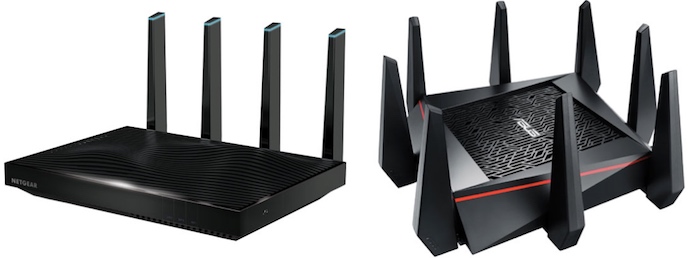
Pushing 802.11ac to Extremes: AC5300
When they arrived on the scene, the first wave of Wi-Fi routers that officially supported the 802.11ac standard were impressive and offered a big boost in speed compared to the previous generation 802.11n models.
Those 802.11n routers—which had been the standard for roughly six years—delivered W-Fi speeds in the neighbourhood of 450Mbps. The first generation of 802.11ac routers could nearly triple this speed, delivering a combined data throughput of 1300Mbs. That’s when the term “Gigabit Wi-Fi” came into play.
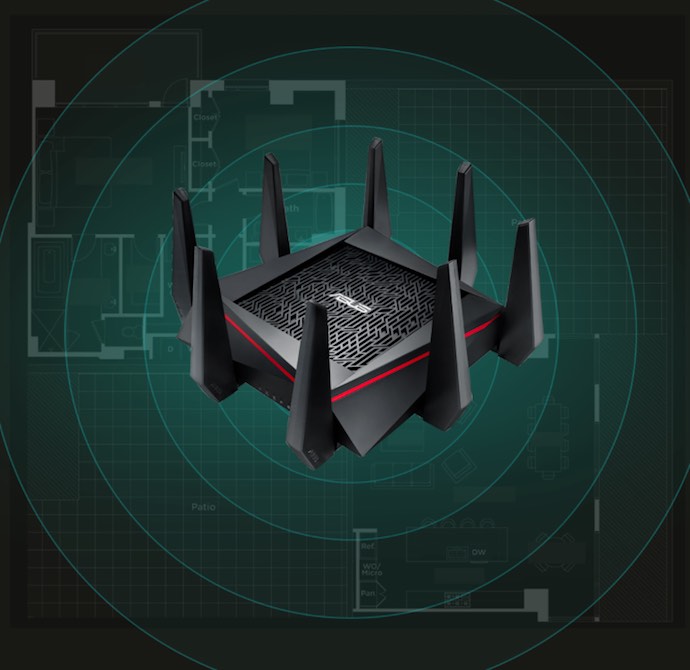 The advantages of 802.11ac aren’t limited to raw speed. The standard also ensures wireless networks are able to meet the demands of modern households, where Wi-Fi capable devices have multiplied at an explosive rate and the volume of data they move around has also ramped up. 802.11n Wi-Fi was more than sufficient for a time when most homes had a computer or two using Wi-Fi, along with maybe a game console and a smartphone or two. Today, many homes have dozens of devices connected to their Wi-Fi network at a time, and instead of standard definition video, it’s HD or even 4K.
The advantages of 802.11ac aren’t limited to raw speed. The standard also ensures wireless networks are able to meet the demands of modern households, where Wi-Fi capable devices have multiplied at an explosive rate and the volume of data they move around has also ramped up. 802.11n Wi-Fi was more than sufficient for a time when most homes had a computer or two using Wi-Fi, along with maybe a game console and a smartphone or two. Today, many homes have dozens of devices connected to their Wi-Fi network at a time, and instead of standard definition video, it’s HD or even 4K.
802.11ac introduced technology like support for up to eight spatial streams (double the previous generation) and beamforming that targeted devices with Wi-Fi instead of blind broadcasting.
With AC5300 routers like the ASUS RT-AC5300 and Netgear Nighthawk X8, 802.11ac technology is being pushed to its limits and features that weren’t offered in first generation Gigabit routers are being employed. For example, these routers feature simultaneous tri-band Wi-Fi. Instead of the usual 5GHz and 4GHz radios, they have two separate 5GHz bands and the 2.4GHz radio is a new NitroQAM version that boosts its speed to 1000Mbps. The combined throughput of those three bands comes to 5300Mbps. They also support MU-MIMO, which further improves network efficiency (and speed).
So AC5300 is like the AC1300 from a few years ago, but turbo-charged to deliver four times the total throughput and even better able to support multiple devices.
Clash of the Wi-Fi Titans: Comparing the ASUS RT-AC5300 and Netgear Nighthawk X8
I had the opportunity to try out two new AC5300 routers. Before getting to my experience, here’s a quick look at some of their key specs.
| ASUS RT-AC5300 | Netgear Nighthawk X8 | |
| Simultaneous Tri-Band Wi-Fi (2 x 5GHz + 2.4Ghz) | Yes | Yes |
| Antennas | 8 external antennas, adjustable | 8 amplified antennas: 4 internal, 4 external adjustable |
| MU-MIMO Support | Yes | Yes |
| Automatic Load Balancing | Tri-Band Smart Connect | Tri-Band Smart Connect |
| Beamforming | AiRadar universal beamforming | Implicit and Explicit beamforming |
| Dynamic QoS | Yes + WTFast game acceleration | Yes |
| Media Server | AiPlayer app compatible enhanced media server | DLNA Server |
| Ports | 1 x 10/100/1000 BaseT WAN, 4 x 10/100/1000 BaseT LAN, 1 x USB 2.0, 1 x USB 3.0 | 1 x 10/100/1000 BaseT WAN, 6 x 10/100/1000 BaseT LAN, 1 x USB 2.0, 1 x USB 3.0 |
| Wi-Fi Security | 64-Bit WEP, 128-Bit WEP, WPA/WPA2-PSK, WPA Enterprise, WPA2 Enterprise, Radius with 802.1x, WEP | WPA/WPA2-PSK
|
| Firewall and Advanced Security | SPI firewall, DoS protection, SPI detection | SPI and NAT firewall, DoS protection |
| Size | 24.5 x 24.5 x 6.5 cm, weighs 1.81 kg | 31.6 x 26.4 x 6.1 cm, weighs 1.68 kg |
Both of these routers make an immediate impression. They are huge, bristling with antennae and more than a little intimidating looking.
Here’s the thing, though. Even though I know that they are capable of destroying my existing 802.11ac router, I didn’t see a dramatic improvement when using either the ASUS RT-AC5300, or the Netgear Nighthawk X8. That’s not their fault. It’s not false advertising. The problem is that my Wi-Fi demands just aren’t enough to push my existing router to the limit and most of my devices lack support for the cutting edge technology like MU-MIMO that would let them experience significant individual gains. This is an important reminder that 5300Mbps is not the maximum speed a single device can get, it’s the maximum combined throughput of all three Wi-Fi bands. Without support for not just 802.11ac, but also MU-MIMO, individual devices aren’t likely to see a huge speed increase with an AC5300 router—at least not unless your network is over-crowded.
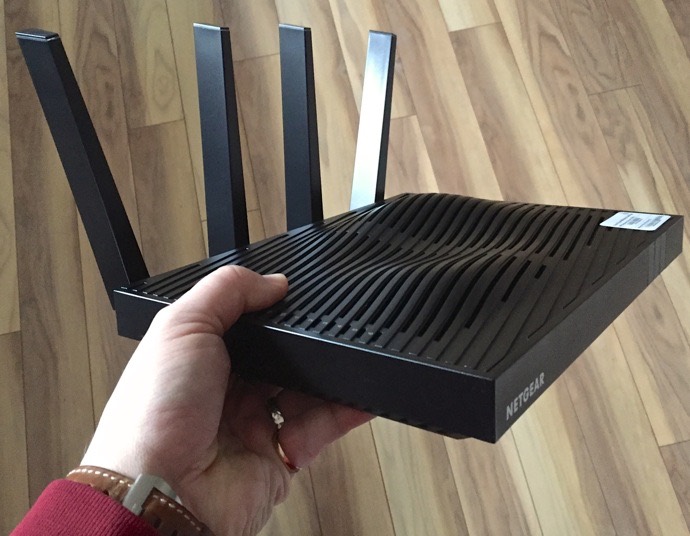
As a result, the usual tests of Wi-Fi speeds like copying files from one device to another showed only modest improvement, if anything, compared to my current setup. The one definite gain was network coverage. With their powerful amplifiers and multiple antennas, both of these routers eliminated Wi-Fi “iffy” zones in my house and blasted a strong signal even to the depths of the back yard.
If I had to choose between the two, I’d probably pick the ASUS RT-AC5300. I prefer its aggressive look but more importantly, its gaming optimization will be a handy feature as my kids get more into online gaming.
Light Commercial Applications
My Wi-Fi demands may not have been enough to showcase the capabilities of an AC5300 router, but there are other situations where one would make a dramatic difference.
The ASUS RT-AC5300 and Netgear Nighthawk X8 are technically being sold as consumer routers, but the throughput, support for multiple simultaneous connections and advanced security they offer make them powerful enough for light commercial applications.
Small offices, retail stores and coffee shops could potentially make use of these routers. They all tend to have many users hitting Wi-Fi simultaneously and if you want to see a collection of mobile devices that support the latest technology like MU-MIMO, a coffee shop is a great place to go. The ASUS RT-AC5300 and Netgear Nighthawk X8 are priced at a premium compared to typical consumer routers, but they are a bargain compared to many routers aimed at the commercial market.
Who Would Buy an AC5300 Router for Home Use?
For the average person, a router like the ASUS RT-AC5300 or Netgear Nighthawk X8 is overkill. I discovered that during my own time with these two monsters. I just don’t have the Wi-Fi demand to push my existing 802.11ac router past it limits and I don’t have enough new devices on my network that can take advantage of the advanced features they offer, like MU-MIMO support.
However, if there are hardcore gamers in your home, a solid case could be made, especially for the ASUS RT-AC5300 with its built-in WTFast game acceleration technology. The same if you have multiple devices frequently streaming high demand loads like 4K video.
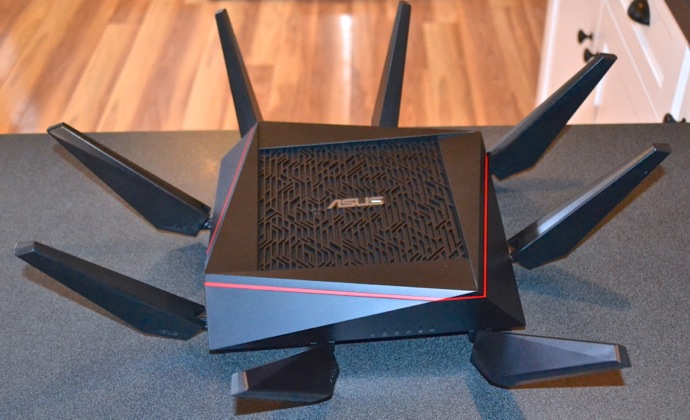
Would I buy one now? Let’s put it this way. An AC5300 router like these does not come cheap and for someone like myself who already has an 802.11ac router in place, it wouldn’t make sense to do so.
However, if you are replacing an old 802.11n router, then the mega-upgrade is worth considering. I can almost guarantee you won’t come close to taking full advantage of the ASUS RT-AC5300 or Netgear Nighthawk X8 at first, but demands on Wi-Fi are only increasing. Sony is launching a 4K movie streaming service in April and rumours are flying about a 4K capable Playstation 4. If streaming Ultra HD content wasn’t punishing enough on Wi-Fi, the follow-up to Guardians of the Galaxy is being filmed in 8K … Samsung’s new Galaxy S7 and Galaxy S7 Edge support MU-MIMO and eventually many of the devices on your Wi-Fi network will be able to take full advantage of the technology. So the case could be made for future-proofing.
An AC5300 router is definitely a bigger investment upfront, but in a few years when the rest of us are forced to upgrade again as Ultra HD video, mobile devices and smart appliances congest our Wi-Fi, those who chose an ASUS RT-AC5300 or Netgear Nighthawk X8 will be able to sit back and enjoy a network that’s still humming.
You can fine the right router for your home or business online at Best Buy.




































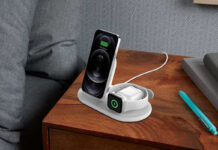


Ultimately, your ISP is your bottleneck, and it’s importan to factor in what you’re getting from them when picking out a router. Don’t spend $200 on a router when you’re only getting 15 Mbps from your service provider.
JB
That’s a good point. Some households do have a lot of local Wi-Fi activity happening as well, though. For example, I have a local iTunes library that serves up video content to a bunch of Apple TVs.
Comments are closed.